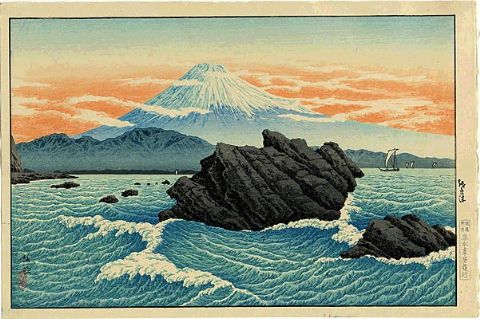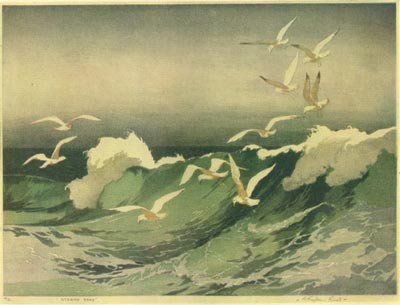Posted by Dave Bull at 2:18 PM, February 15, 2009
Part-timer Ichikawa-san is coming over tomorrow morning to pick up the batch of prints, along with all the accompanying paperwork necessary for shipping. She has a pile of the books already made up, so the prints will be flying away to their new homes bit by bit over the next ten days or so.
It's now time for me to prepare the next batch of printing paper (another 112 sheets) for the second half of the run, but before I do, there's - as usual - a pile of paperwork waiting on my desk. Among the things on my 'to do' list:
"put the quote from the Ivins book on the RoundTable, and see what people think of it ..."
Do you know the book I mean? "How Prints Look", by William Ivins, Jr., published by the Metropolitan Museum of Art in New York in 1943, and since re-issued a couple of times. My copy cost 80¢ a couple of decades ago; I think you can find it in used bookshops anywhere ...
Most of the book is nothing particularly to do with my type of woodblock work, as it's all about the techniques used in making western prints, but in the essays at the back, he speaks in general terms, applicable to any kind of art.
There is one particular quote that I have always found fascinating, as it cuts very close to the bone for me. Rather than talk about it too much to start with, just let me put it on the table for you to read.
I would - of course - be interested in hearing what you might have to say about this, and also - of course - with specific reference to my own type of work.
Excerpt from How Prints Look, William M. Ivins, Jr.
"It may in general be assumed that the greater an artist the simpler his prints are from a strictly technical point of view. [...] The more complex and artificial the technique of a print, especially in the way its lines are laid, the more certain one may be that its maker was a craftsman translator and not a creative artist. The price of virtuosity is abject slavery to a complaisant tool, that of creative artistry is willful dominance over a recalcitrant tool. The world has a curious but encouraging habit of forgetting the virtuosi. The only two techniques that really are of artistic importance are rarely or never mentioned in essays and books upon the graphic techniques. They are those of pictorial imagination and sharp-sighted, sensitive draughtmanship. No one can ever be taught these two great techniques, for they are part of the eternal mystery of personality and its growth, to be recognized but not to be rationalized or reduced to a method. They can no more be imitated than wit."
Mr. Ivins argument is a bit confusing to me but that is most likely that I am not translating it correctly.
The greater an artist the simpler his prints are from a strictly technical point of view.
I am guessing this is a fact and not an opinion. I have marveled at some realistic landscape moku hanga prints and have come to realize that what seemed like an infinite amount of block work really boils down to 5 or so blocks cleverly layered. I myself and learned and experimented in these ways for two reasons 1.) not to waste resources and 2.) let's face it, the general public does not appreciate the intricacies of our craft enough to warrant the energy expenditure on such a venture. I am confused a bit when he gets to
The more complex and artificial the technique of a print, especially in the way its lines are laid, the more certain one may be that its maker was a craftsman translator and not a creative artist.
I suppose I am hung up on the word "complex". Is he inferring that intricacy equals rote draftsmanship and that one cannot possibly be creative and at the same time render exceptional details mirroring that of nature? My mark making is notoriously intricate but my practice is anything but rote. I am supposing that you are the same way David judging from your recent nature editions.
The only two techniques that really are of artistic importance are rarely or never mentioned in essays and books upon the graphic techniques. They are those of pictorial imagination and sharp-sighted, sensitive draughtmanship.
I couldn't agree more with both statements. We are a dying breed.

During the course of my life, for a considerable number of years, I've been in and around the 'art' world. I've had many occasions, talking with a variety of players to ask the simple question, "What is the definition of 'art'?". I've heard many divergent approaches to defining 'art' and have come to the conclusion that a satisfactory definition does not exist.
Any discussion which starts with "It may in general be assumed that the greater an artist..." is entirely meaningless without first having a solid definition of 'art'. Only after such a foundation has been established and generally accepted, should anyone attempt to define what makes some art 'greater' than other art.
Many art experts attempt to delineate between 'artists' and 'craftsmen'. That's the territory that Ivins is exploring. Like most folks who embark down this path, he's got a vague, emotional, and personal distinction between the two, based on his sense of taste.
I share Ivins' appreciation of elegance and simplicity, so we have some commonality. But, I totally object to his pompous approach of putting himself into the position of arbiter in determining who is and who isn't an 'artist'. In that respect, he is an exceptionally fine artist, a bullshit artist.
Marc

There is a point in learning any mechanical skill that it becomes imbedded in the cerebellum and becomes automatic as opposed to conscious. Anyone who has learned to play a musical instrument will know how a difficult passage with practice will become automatic, like breathing or walking.
There are very few artists in whom their technique has become so natural as to be almost invisible. Degas was perhaps one if you look at his dancers done in chalk/gesso. You can insert any of the others.
Far more common are the artists who fill with detail and make virtuosity of technique the core content of their art irrespective of the subject.
I agree with Ivin's that geniuses are born so and not often. Draughtmanship and composition however can be learned and many non-genius artists have produced in their lifetimes great and lasting works.

Interesting issue Dave!
I'll add my reactions later, but to me - in a nutshell - it finally all boils down to this: when I see/read/listen (to) a print/painting/movie/sculpture/book/music and there is some sort of resonance in me in terms of recognition and/or beauty (all that being quite subjective of course), then I'll be drawn to see/read/listen (to) more of that. Otherwise I won't.
Irrespective of whether that recognition and beauty is shared by other people, or complies with what so-called 'official experts' have to say on the subject.

I used to have that book! but I think it got lost or sold during the move before last. I tend to think he is talking about the difference between say one of those sketchy brilliant Rembrant etchings and and an engraving that has perfect volumes created by fishnet stockings (know what I mean?) The latter is technically perfect but somehow it doesn't quite sing with the human nervous system. Which is not to say one cannot be in some awe of technical proficiency, I think it would be hard to live with though.
A quote from Matisse goes, more or less, thusly "Much of the beauty of art arises from the the struggle of the artist with a limited medium." Struggle on!

I guess it's this particular line that I focus on:
The more complex and artificial the technique of a print, especially in the way its lines are laid, the more certain one may be that its maker was a craftsman translator and not a creative artist.
Now my previous work - making ukiyo-e reproductions - was both complex, and artificial. I was indeed acting as a 'craftsman translator', and not as a 'creative artist'. No argument. No problem.
I am having trouble coming to grips with my current situation though. Must those two words - complex and artificial - be necessarily tied together? The print I have just finished is indeed complex, but is it artificial? I am far too close to it to tell.
But it seems to me that with the recent couple of prints - and their very heavy reliance on photographic methods for their preparation - we are indeed moving a bit too far past 'complex', and well towards the 'artificial', and this is leaving me somewhat uncomfortable.
The pool of foamy water in my print looks fabulous ...

... but it's not really woodblock printmaking - at least not the way that I want to see it done!
Look at this water, for comparison (image stolen from Marc Kahn's shotei.com website):

Definitely not photographic water; quite stylized; very woodblocky ... But you know what? I don't like it at all! There's no emotion or real sense of the weather at all; it just fills up space on the sheet of paper. How about this water though!

This guy got it! At least he almost got it; the cresting foam is kind of strange I think. But the stylization! Woo-hee!
I wonder how he did it, and if he sat there on the seawall sketching, or worked from a photograph, or just relied on his memory of what the surface of the sea 'feels' like ...

I think the difference between the last two examples is the difference between stylized and simplicity. Or to draw a metaphor the difference between an epic ballad that goes on for too long and a Haiku. As Leonardo Da Vinci once said when we were haivng tea together "Simplicity is the ultimate sophistication".

I like that quote,the way that it is expressed and totally agree. That is the essence of art, IMHO
Still, there is no accounting for taste. There is a saying that goes with that:
"There is no accounting for taste, said the old woman as she kissed the cow"

Looking over at all the woodblock prints that I collected so far - including yours - for me the keyword is: stylized (and not necessarily simple!).
So, if you'd ask me "what type of prints would you like me to design for the rest of the My Solitudes series", then I would say "stylized ones like River in Summer and Seacoast in Autumn". For me those two are definitely the most attractive prints of the series...

I am so glad you shared this quote. I am a woodblock printmaker, quilter and beginning rug hooker-my grandmothers all hooked rugs from wool. I found myself asking the same kinds of questions about craftmenship and creativity and what really makes a successful quilt, rug, print? I think it is when a piece reaches the viewer emotionally without any static-worded thoughts and anaylsis. That I think is where the creativity comes, in the knowing a medium well enough to translate a visual image which will strike a place within a viewer and touches their being.





